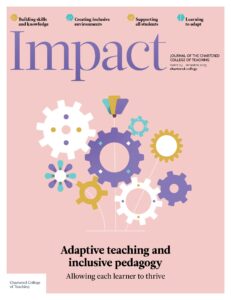Navigating the storm: Practical applications of rhythmanalysis in education for students with pathological demand avoidance

EMMA LOUISE PRICE, PRIMARY TEACHER AND EDUCATION DOCTORATE STUDENT, BIRMINGHAM CITY UNIVERSITY, UK
Introduction
Imagine a school environment where every request, no matter how small, feels like an insurmountable challenge. From the perspective of a student with pathological demand avoidance (PDA), the rigidity of mainstream classroom learning environments only heightens their anxiety and avoidant behaviours, sidelining them from active participation. There is rising interest in school absenteeism and exclusion, with a clear message that students must be in school, despite a growing number seeking alternative placements or home schooling (Sasso and Sansour, 2024). In the 2022/23 academic year, 1.6 million UK children were persistently absent, with pupils with SEND (special educational needs and disabilities) showing a particularly pronounced rate of absence (DfEDepartment for Education - a ministerial department responsible for children’s services and education in England, 2023). The impact of PDA on access to education can be profound, with key statistics from the PDA Society’s Being misunderstood in education report (2019) stating that 70 per cent of students with PDA are not in school or regularly struggle to attend. This persistent absenteeism contributes to educational inequalities, poorer academic outcomes and social isolation. Despite government measures to address this, many students with PDA remain unable or struggle to persistently access mainstream education, meaning that they contribute to the percentage of absent pupils. How can we reshape our approach to create a supportive educational system that accommodates the unique needs of students with PDA?
French philosopher Henri Lefebvre’s concept of ‘rhythm’ refers to the patterns and cycles of activities and interactions that shape the educational environment, highlighting how temporal and spatial rhythms influence the experiences and behaviours of students and teachers in education (Lefebvre, 2004, 2014). Within the dynamic landscape of education, disruptions can challenge the established rhythms of daily school life. The resulting ‘arrhythmia’ from these disruptions, likened to emerging storms, reveals opportunities to rethink and reshape educational practices. This perspective piece explores the concept of rhythmanalysis, particularly in relation to students with PDA, and provides practical applications for classroom teachers to create more inclusive and supportive learning environments.
What is pathological demand avoidance?
PDA is a proposed subtype of autism spectrum disorder (ASD). It is characterised by difficulties with compliance and by an extreme resistance to everyday demands and requests, including perceived demands, often due to high anxiety levels. PDA students may go to great lengths to avoid demands; these can include refusing, arguing, negotiating and/or strong emotional outbursts (PDA Society, 2023; Truman et al., 2021).
Some common traits associated with PDA include:
- a strong need to control their environment and the people around them
- rapid mood swings and impulsive behaviour
- difficulty completing tasks that they do not prefer
- avoidance of everyday tasks and social expectations
- use of social strategies to avoid demands, such as making excuses, distraction or using charm to deflect requests.
Clinically speaking, PDA is not officially listed as a separate diagnosis in the Diagnostic and Statistical Manual of Mental Disorders (DSM-5). Yet this has remained a controversial subject among clinicians, educators and further academic spheres (Truman et al., 2021; Green, 2024). Although it is increasingly acknowledged within the autistic community and local authorities, the lack of formal recognition significantly impacts the educational experiences of this group of students through misclassification of need, often resulting in a failure to provide suitable strategies and support (Truman et al., 2021). However, it is argued that PDA can be related to other conditions, such as attention deficit hyperactivity disorder (ADHD) and anxiety disorders (Green, 2024). These associations highlight the complex and multifaceted nature of PDA, which often requires a thorough approach to diagnosis and support, especially in educational settings, where traditional approaches may not be effective.
Research shows that approximately one to two per cent of the global population are autistic, with up to 20 per cent of autistic individuals exhibiting PDA behaviours (Gillberg et al., 2015; Roman-Urrestarazu et al., 2021). The prevalence of PDA is uncertain; nonetheless, it may be useful to identify any avoidant behaviours and, where they are evident, evaluate measures to reduce demand. In school, students might struggle to engage with classwork and the routines of the day, leading to misunderstandings with teachers, who may perceive them as defiant or uncooperative. This can result in punitive measures that further exacerbate students’ anxiety. At home, regular tasks such as getting dressed or completing homework may lead to challenges and stress for both the student and their family.
The educational landscape, rhythmanalysis and PDA
When there is an expenditure of energy, there is rhythm.
Lefebvre, 2004, p. 4
Rhythmanalysis, as developed by the French philosopher Henri Lefebvre, is a method for studying the rhythms of everyday life and their impact on our experiences and environments (Lefebvre, 2004). Rhythms permeate our daily lives, governing our routines, bodily functions, movements and interactions with the environment. Beyond mere routine, they bring order and predictability amid the uncertainties of our surroundings, shaping our sense of belonging within daily practices (Chen, 2020). Considering the complexities faced by PDA students, it is essential to explore innovative approaches such as rhythmanalysis in order to better understand and support students with PDA in educational settings. According to Doyle and Kenny (2023), the extent of ‘demand avoidance’ associated with PDA presents significant challenges for schools in offering an appropriate educational environment, although it is not impossible. These students, often misunderstood and mislabelled as defiant, are grappling with profound anxiety and a need to control their surroundings.
When identifying these rhythms, broadly speaking they fall into the following categories:
- eurythmia: characterised by navigational confidence and the ability to keep up with the fast-paced rhythms of the school day
- arrythmia: ‘disruptions’, associated with anxiety, fatigue and a sense of displacement.
For teachers, this can be a valuable tool with which to analyse and improve the learning environment, particularly for students with PDA. In a school setting, rhythmanalysis involves observing and understanding the different rhythms that occur throughout the day (Lyon, 2020; Gore Langton and Frederickson, 2016). Consider these rhythms:
External rhythms (imposed by schedules)
- Bell timings: The school day is marked by the ringing of bells, indicating transitions between lessons, breaks and assemblies
- Class periods: Lessons follow a set rhythm, typically around 40 to 60 minutes long, influencing the pace of teaching and learning
- Breaks and lunchtimes: Scheduled pauses introduce restorative rhythms, where social interaction and relaxation occur.
Biological rhythms (natural to students and teachers)
- Energy fluctuations: Attention spans and energy levels often dip mid-morning and after lunch, impacting engagement during these periods
- Sleep cycles: Many students’ sleep patterns clash with early school start times, creating a mismatch between biological and imposed rhythms.
Classroom rhythms (emerging from activities)
- Lesson flow: Activities like instructions, group discussions and independent work generate their own tempos and transitions
- Movement: The flow of students moving and interacting between classes or within the classroom space creates its own rhythms
- Behavioural dynamics: Classroom management introduces micro-rhythms, as teachers respond to disruptions or adjust to students’ needs
- Exams and holidays: Assessment periods, changes to the timetable due to seasonal practices, and term breaks punctuate the school year, creating peaks of stress or relief for students
- Changing topics: Curricula often introduce new topics or units at specific intervals, shifting focus and activity patterns.
By paying attention to these patterns, teachers can gain insights into how time and space are organised and experienced by students with PDA (Middleton, 2017). Understanding how individuals and social groups create, modify and interpret their world is crucial in navigating these disruptions (Truman et al., 2021). In educational settings, this perspective can help us to understand how students with PDA, who often resist demands and exhibit extreme emotional responses, interact with and disrupt the normative rhythms of school life, often reinforced by educational policies and expectations. By delving into their lived experiences, through mapping out these disruptions, we can uncover the critical importance of empathy and tailored support in fostering an inclusive and nurturing educational environment.
Navigating the emerging storm
Likened to a storm, a student with PDA’s need for control and autonomy within the educational environment can manifest through resistance to demands, difficulties with social interactions and emotional instability, which may disrupt the routine of a school day. Just as storms vary in intensity and duration, these arrhythmic shifts can manifest in different forms and degrees of severity. These shifts, while potentially chaotic, also offer opportunities to challenge and rethink normative beliefs and practices (Lefebvre, 2004, 2014). Rethinking learning environments is not merely about physical layouts; it is about crafting emotional and social landscapes that foster inclusionAn approach where a school aims to ensure that all children are educated together, with support for those who require it to access the full curriculum and contribute to and participate in all aspects of school life and respect for students’ unique needs. We need to shift from viewing the environment as a backdrop to recognising it as a pivotal player in the educational journey.
Understanding these behaviours through the lens of rhythmanalysis allows educators to see them not as mere defiance but as significant moments that challenge the status quo and offer insights into the needs of these students. This involves paying attention to the times when students are most engaged and when disruptions occur.
Practical applications for teachers
By integrating the principles of rhythmanalysis and adapting classroom practices, educators can help these students to feel secure, engaged and respected. Considering research findings, the following practical applications offer strategies and insights to enhance the educational experience for students with PDA, ensuring that they can thrive academically and socially (Truman, 2021).
1. Flexible routines and structures
- Adaptability: Create flexible schedules that allow for adjustments based on the needs of students with PDA. This can help to reduce anxiety and resistance by providing a sense of control and predictability.
- Choice and autonomy: Be clear and straightforward but also flexible in how demands are communicated, encouraging independence and giving the student a sense of control over their environment and activities. This can involve offering choices or framing requests in a way that feels less direct. For example, allowing a student to choose the order in which they complete assignments can make them feel more in control.
2. Supportive classroom environment
- Safe spaces: Provide a supportive and caring environment that helps the student to feel safe and understood. These spaces should be quiet and free from distractions, providing a haven for self-regulation. Building trust is crucial for effective engagement. Look for and take note of areas in the classroom to where students are retreating when feeling overwhelmed.
- Emotional support: Foster a supportive atmosphere by acknowledging and validating the emotions of students with PDA. Use calming techniques and positive reinforcement to help them to manage their emotions. Accept the student’s feelings and behaviours without judgment; this involves recognising that the avoidance is driven by anxiety and a need for control.
3. Collaborative learning
- Peer support: Encourage collaborative activities that promote peer support and social interaction. Allowing students with PDA the control to pair with classmates can help them to feel more included and supported. Use humour and play to engage students in order to reduce anxiety; this can help to make demands feel less threatening and more manageable.
- Group projects: Design group projects that allow for varied roles and responsibilities, enabling students with PDA to contribute in ways that align with their strengths and interests.
4. Individualised learning plans
- Personalised goals: Involve families to develop individualised learning plans that set realistic and achievable goals. These plans should be tailored to students’ unique needs and abilities, focusing on incremental progress rather than rigid benchmarks.
- Regular reviews: Conduct regular reviews of these plans with input from the student, parents and other professionals to ensure that they remain relevant and effective.
5. Professional development and training
- Teacher training: Provide ongoing professional development for teachers on understanding and supporting students with PDA. Training should include strategies for managing challenging behaviours, reducing demands, fostering emotional resilience and creating inclusive classrooms.
- Collaborative workshops: Organise workshops where teachers can share experiences, challenges and successful strategies for working with students with PDA. This collaborative approach can foster a community of practice and continuous learning.
Conclusion
Understanding the rhythms within a school day is crucial for fostering an inclusive learning environment that benefits all students, and not just those with pathological demand avoidance. By recognising and accommodating the natural patterns and cycles of activities and interactions, educators can create a more flexible and responsive educational setting. This approach allows for the adaptation of instruction and support, catering to the diverse needs of students. It also helps in identifying and mitigating stress points throughout the day, promoting a more harmonious and productive learning atmosphere. A nuanced appreciation of these rhythms can lead to a more equitable and supportive environment, where every student can thrive.
- Chen Y (2020) The configuring of ‘context’ in rhythmanalysis. In: Crespi P and Manghani S (eds) Rhythm and Critique: Technics, Modalities, Practices. Edinburgh: Edinburgh University Press, pp. 201–217.
- Department for Education (DfE) (2023) Pupil absence in schools in England. Available at: https://explore-education-statistics.service.gov.uk/find-statistics/pupil-absence-in-schools-in-england (accessed 24 March 2025).
- Doyle A and Kenny N (2023) Mapping experiences of pathological demand avoidance in Ireland. Journal of research in special educational needs 23(1): 52–61.
- Gillberg C, Gillberg I, Thompson L et al. (2015) Extreme (‘pathological’) demand avoidance in autism: A general populations study in the Faroe Islands. European Child and Adolescent Psychiatry 24: 979–984.
- Gore Langton E and Frederickson N (2016) Mapping the educational experiences of children with pathological demand avoidance. International Journal of Research in Special Educational Needs 64(4): 254–263.
- Green A (2024) An exploration into the educational experiences of school aged children with a demand avoidant profile of autism in England. MEd Dissertation, University of Birmingham, UK. Available at: www.pdasociety.org.uk/wp-content/uploads/2024/12/AMELIA-GREEN_AN-EXPLORATION-INTO-THE-EDUCATIONAL-EXPERIENCES-OF-PDA-CHILDREN-DISTRIBUTION-VERSION-v3.0-.pdf (accessed 31 March 2025).
- Lefebvre H (2004) Rhythmanalysis: Space, Time and Everyday Life, 1st ed. London: Continuum.
- Lefebvre H (2014) Critique of Everyday Life: The One Volume Edition. London: Verso.
- Lyon D (2020) Rhythmanalysis: Research Methods. London: Bloomsbury Academic.
- Middleton S (2017) Henri Lefebvre on education: Critique and pedagogy. Policy Futures in Education 15(4): 410–426.
- PDA Society (2019) Being misunderstood in education: Experiences of the pathological demand avoidance profile of ASD. Available at: www.pdasociety.org.uk/wp-content/uploads/2019/09/Being-Misunderstood-in-Education.pdf (accessed 31 March 2025).
- PDA Society (2023) Autism & PDA. Available at: www.pdasociety.org.uk/about-pda/autism-and-pda (accessed 31 March 2025).
- Roman-Urrestarazu A, van Kessel R, Allison C et al. (2021) Association of race/ethnicity and social disadvantage with autism prevalence in 7 million school children in England. JAMA Pediatrics 175(6): 1–11.
- Sasso I and Sansour T (2024) Risk and influencing factors for school absenteeism among students on the autism spectrum – a systematic review. Review Journal of Autism and Developmental Disorders. DOI: 10.1007/s40489-024-00474-x.
- Truman C (2021) The Teacher’s Introduction to Pathological Demand Avoidance: Essential Strategies for the Classroom. London: Jessica Kingsley.
- Truman C, Crane L, Howlin P et al. (2021) The educational experiences of autistic children with and without extreme demand avoidance behaviours. International Journal of Inclusive Education 28(1): 57–77.










